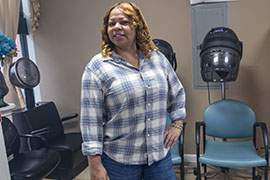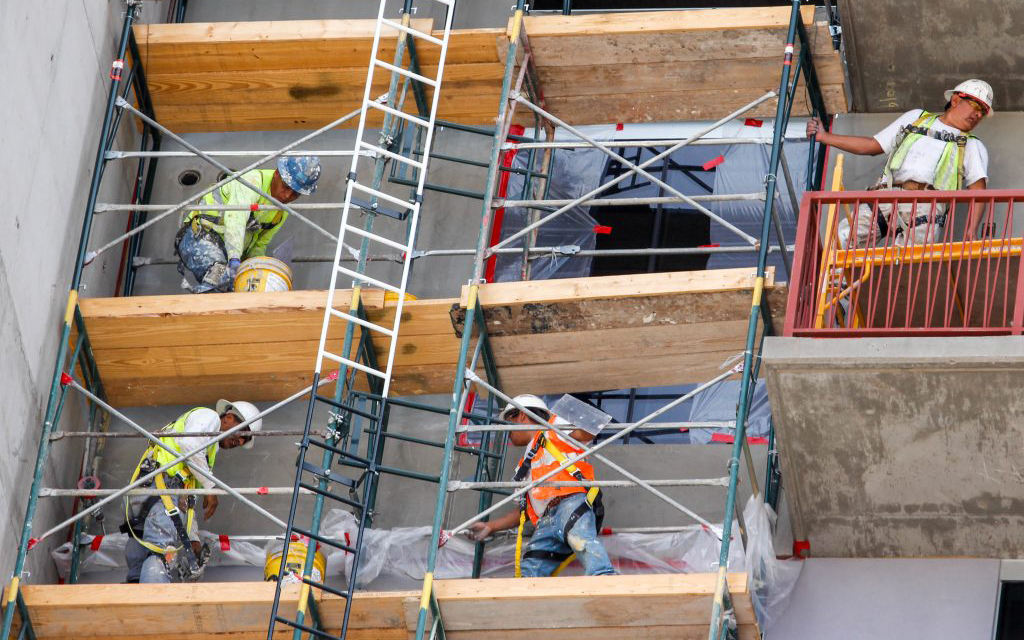- Slug: BC-CNS-Hispanic Middle Class,1550 words.
- 2 photos, graphic available (embed code, thumbnails, captions below).
By Tim Henderson
Stateline
The Hispanic middle class has grown faster than the white or Black middle class in the past decade and has reached near-parity with the white middle class in seven states, including Arizona, according to a new Stateline analysis.
Between 2012 and 2022, the percentage of Hispanic households in the country that qualified as middle class grew from about 42% to 48%, while the share of white households in the middle class remained about the same at 51%. The proportion of Black middle-class households grew more slowly, from 41% to 44%.
Hispanic households’ increasing economic success reflects the maturing of a community that now has more U.S.-born residents. But it also reflects a change in fortunes for immigrants filling service jobs that are in high demand, as well as a broader labor shortage that has pushed up wages.
The gains are fragile, however, and could evaporate over time, said Thomas Saenz, president of the Mexican American Legal Defense and Educational Fund, which advocates for fair labor practices for Hispanic workers.
“While I welcome the progress, it’s not enough to say we’re close to solving the problems with inequity for communities of color. We’re not,” Saenz said. He noted that middle-class income takes a long time to translate into wealth, which often entails passing the financial benefits of homeownership to future generations.
A Pew Research Center report last year found Black and Hispanic adults are more likely than white adults to fall out of the middle class once they’ve reached it, based on data through 2021. Black and Hispanic Americans still lag in college education, which is associated with greater chances of economic success, Rakesh Kochhar, a senior researcher and author of the report, said in an email.
Furthermore, the 10% of Hispanic households that make more than twice the median income is still far lower than the 21% of white households in that category.
For purposes of the analysis, Stateline defined middle class as those households making between two-thirds and twice the state median income adjusted for family size, which ranges from about $70,000 in New Mexico to almost $108,000 in Massachusetts. The analysis is based on responses to the U.S. Census Bureau’s American Community Survey provided by the University of Minnesota at ipums.org.
According to the Stateline definition, a three-person household would have to earn $46,000 to qualify as middle class in New Mexico. The same size family would have to make $53,000 in Florida and $72,000 in Massachusetts and New Jersey. The analysis only included the 15 states where at least 10% of the population is Hispanic.
Among those states, the share of Hispanic families who are middle class is nearly the same as it is for white households in seven states: Arizona, California, Florida, Illinois, Nevada, New Mexico and Texas. In Illinois, Nevada and New Mexico, the Hispanic middle-class share is higher than the white share, and it is within 3 percentage points in the other four states.
That is a sharp change from 2012, when the only state where the Hispanic middle-class percentage approached the share for white households was New Mexico.
Nevada illustrates the progress that Hispanic families have made. There, 57% of Hispanic households are middle class, compared with 52% of white households. That’s a reversal from 2012, when 53% of white households and 49% of Hispanic households were middle class.
Recently, the roller-coaster fortunes of the Nevada tourism industry have been an economic boon to Hispanic workers. Layoffs came in both the Great Recession and the pandemic, but lately jobs have come back with higher wages than before.
Last month, the Culinary Union ratified a contract for 40,000 Nevada resort workers that will raise pay 32% over five years. For Elsa Roldan, a single mother who cleans guests’ rooms at the Bellagio resort in Las Vegas, that would put her over the middle-class threshold she is already approaching at her $25-an-hour pay. In Nevada, the middle-class household income range is about $54,000 to $161,000.
“I couldn’t be more happy or more proud. I feel like I’m middle class, or maybe working class, but I have my benefits, my health care, I own my house in Henderson (a Las Vegas suburb), a very peaceful area where I feel safe, and my son is in college,” said Roldan, who was born in Chicago and lived in Mexico for a time before moving to Las Vegas 17 years ago.
Las Vegas has changed a lot since Antonio Munoz grew up there as the son of laborers who arrived in the 1960s as part of the Bracero Program that brought workers from Mexico to ease U.S. labor shortages. Back then, neighborhoods were segregated into different areas for white, Latino and Black families, but now neighborhoods are mixed, he said.
Munoz is the first in the family to own his own business, the 911 Taco Bar restaurant and catering service. Being a small-business owner is not easy, though.
“I feel like we’re doing pretty well, though there are always ups and downs in the restaurant business. We’ve been busy, but with all the inflation we’re not making any more money,” said Munoz.
He’s considering buying his own restaurant building, but prices are as much as $1.5 million for a simple drive-thru location, and he’s not sure he can afford such a big loan.
The gap between Hispanic and white middle-class households is largest in Northeast states, where living costs are higher. Hispanic residents in states such as Rhode Island and New Jersey are also less likely to be U.S.-born and to speak English easily, factors that have been shown to boost access to middle-class incomes.
The disparity between the Hispanic and white middle class is still 10 percentage points or more in Connecticut, Massachusetts, New Jersey and Rhode Island.
In Rhode Island, where 13% of households are Hispanic, 39% of Hispanic households are middle class compared with 56% of white households, a gap that’s about the same as it was in 2012.
Many Hispanic residents in Rhode Island are single mothers from Central America with low-paying work in house cleaning and child care, with little chance of buying homes and building wealth in today’s inflated housing market, said Marcela Betancur, director of the nonprofit Latino Policy Institute in Providence.
“Being middle class means more than money. It means being able to pass it on to the next generation,” Betancur said, adding that she sees hope for the future in increasing college enrollment among children of immigrants.
Rosa Flores was born in the Dominican Republic and owns a beauty salon in Providence where she moved after studying at a beauty college in New York City about 20 years ago. A single mother, she endured some hard times in the pandemic, living on her savings when the salon, Disnalda, closed for 72 days.
“People came back, thank God, that was a big relief and we’re doing well now,” Flores said. “I do feel middle class and it’s much easier to get by now that I have my own business. I’m very happy.”
The middle-class gap between white and Hispanic households is 12 percentage points in Massachusetts, 11 points in Connecticut and 10 points in New Jersey.
Overall, the growth of the Hispanic middle class is “rapid but not surprising” as the community matures and includes more U.S.-born citizens who are educated and speak English, said William A.V. Clark, a geography professor at the University of California, Los Angeles, who wrote a 2003 book on immigration and the middle class.
A report published this year by The American Journal of Economics and Sociology also emphasized the importance of fluency in English.
The report looked at spending between 2010 and 2019 and found that English-speaking Hispanic families spent more than those who spoke only Spanish on expenses considered middle-class like home mortgages, car payments and family vacations, said author Hua Zan, a family economics researcher at the University of Hawaii.
^__=
Graphic embed code: <iframe title=”Hispanic middle class grows” aria-label=”Map” id=”datawrapper-chart-3sAiV” src=”https://datawrapper.dwcdn.net/3sAiV/11/” scrolling=”no” frameborder=”0″ style=”width: 0; min-width: 100% !important; border: none;” height=”603″ data-external=”1″></iframe><script type=”text/javascript”>!function(){“use strict”;window.addEventListener(“message”,(function(a){if(void 0!==a.data[“datawrapper-height”]){var e=document.querySelectorAll(“iframe”);for(var t in a.data[“datawrapper-height”])for(var r=0;r<e.length;r++)if(e[r].contentWindow===a.source){var i=a.data[“datawrapper-height”][t]+”px”;e[r].style.height=i}}}))}();</script>
^__=
Dominican immigrant Rosa Flores at the Disnalda Beauty Salon she bought in Providence, Rhode Island, after 20 years of living and working in the U.S. Middle-class status can be elusive for Hispanic families in the Northeast where living costs are higher and immigrants tend to be more recent arrivals than in states in the West. (Photo by Michael Salerno/Rhode Island Current)
One factor behind the rise in Hispanic incomes is that immigrants fill high-demand jobs, like construction, amid a general labor shortage. But experts say those gains are fragile, unlike the gains made by longer-term Hispanic resident of the U.S. (File photo by Nicole Neri/Cronkite News)

